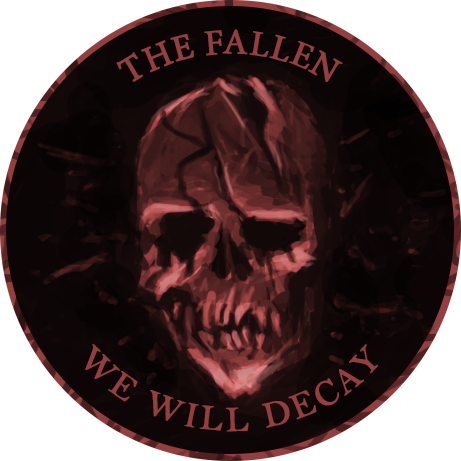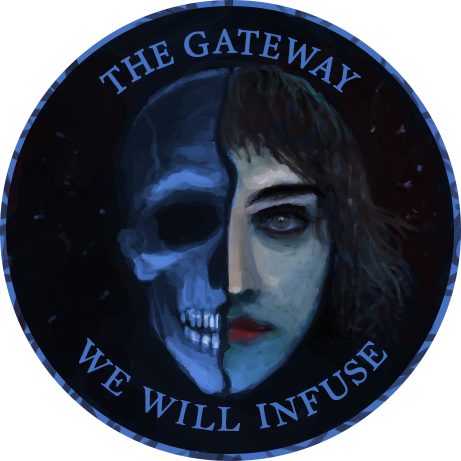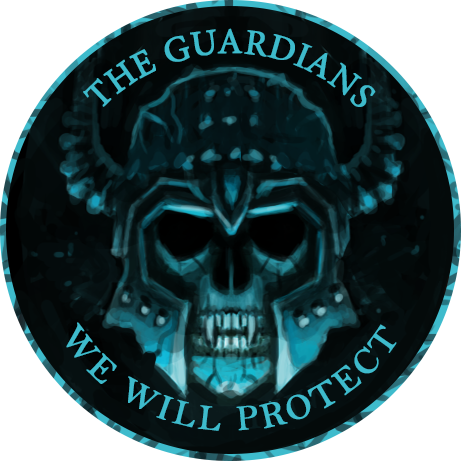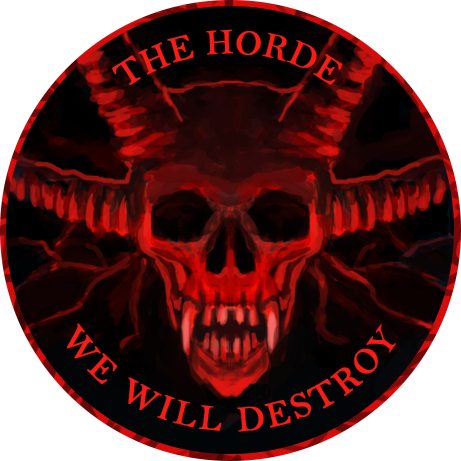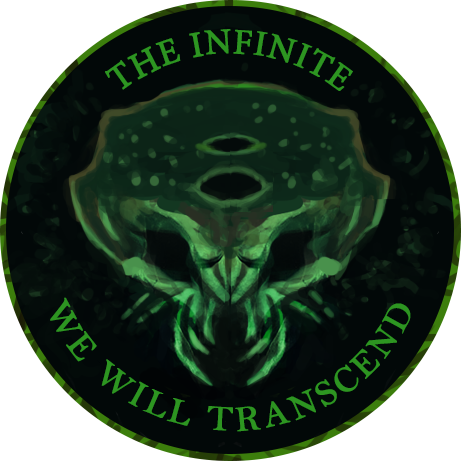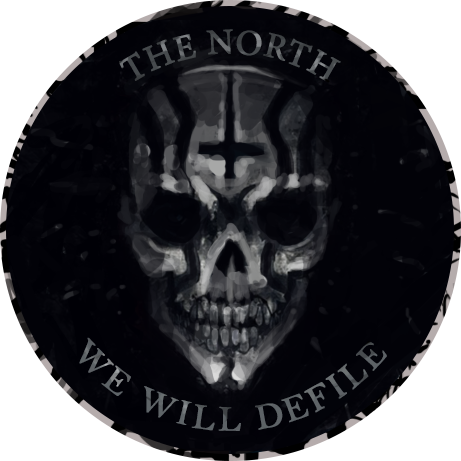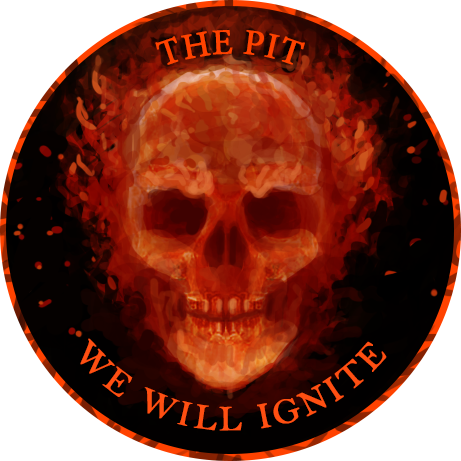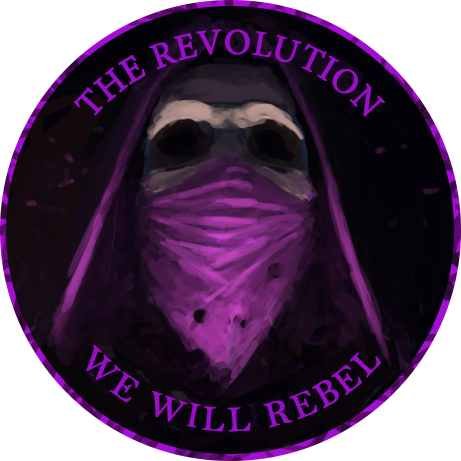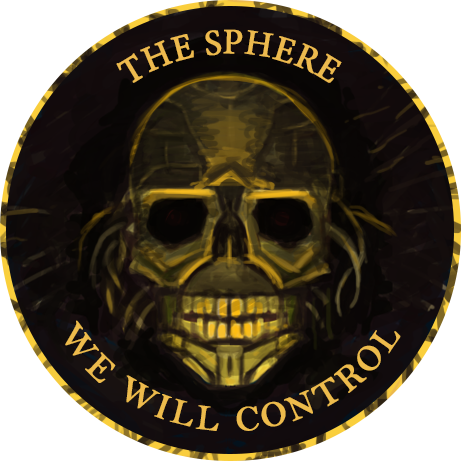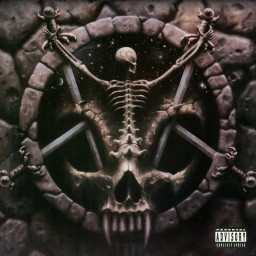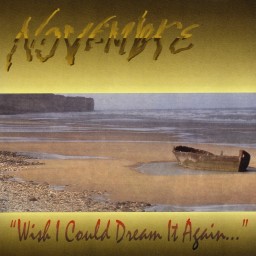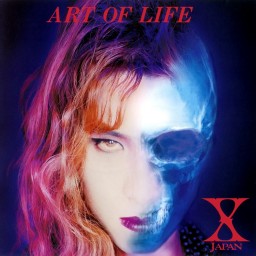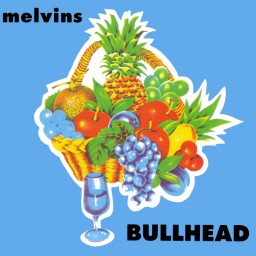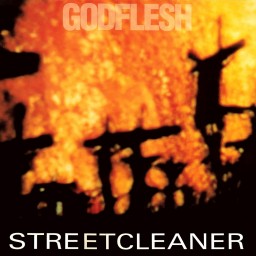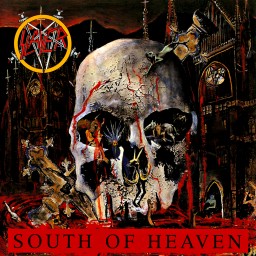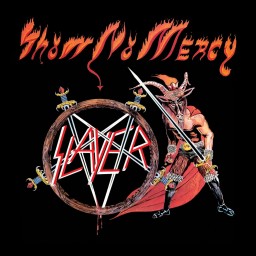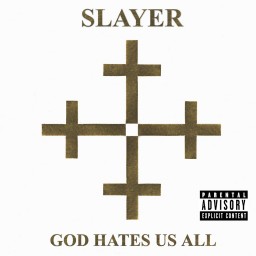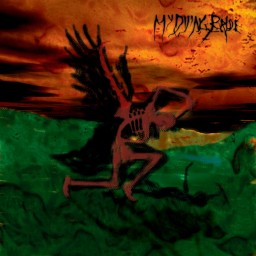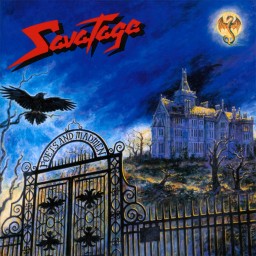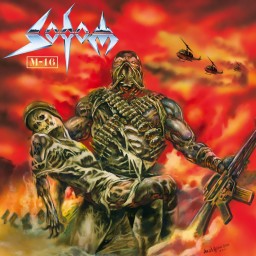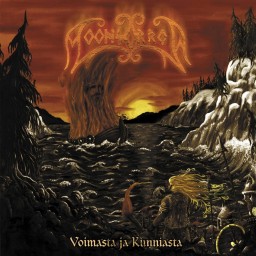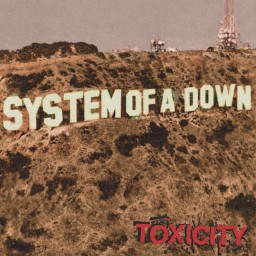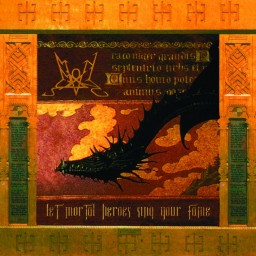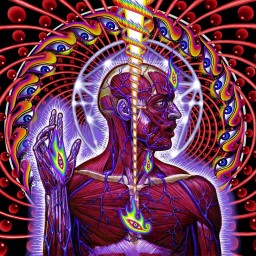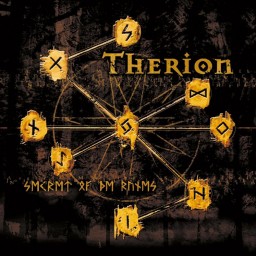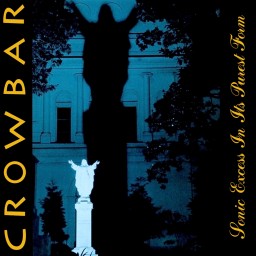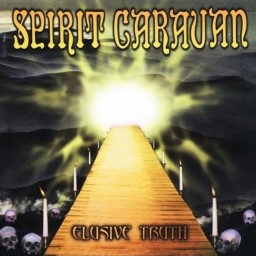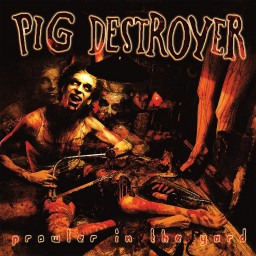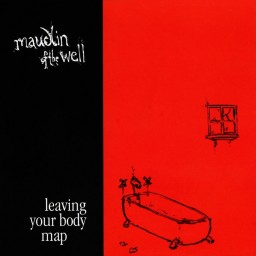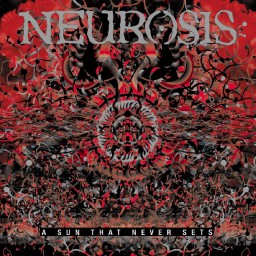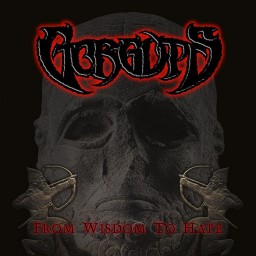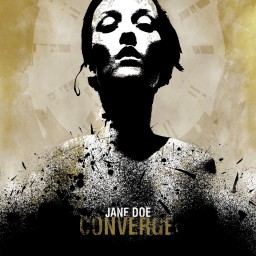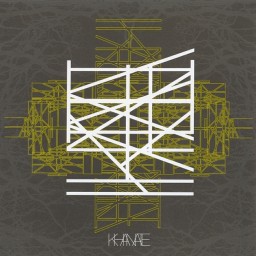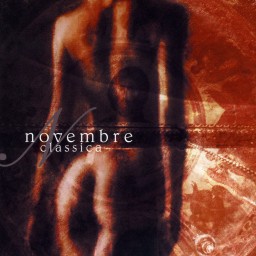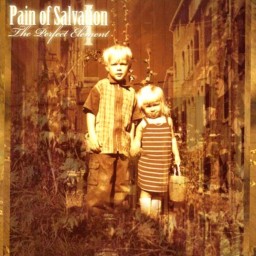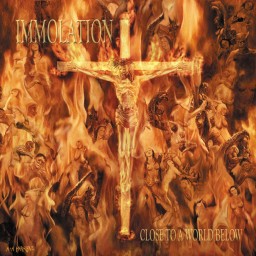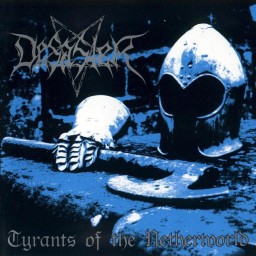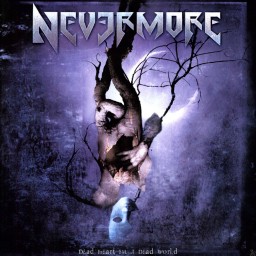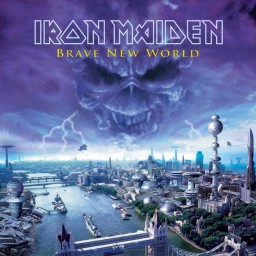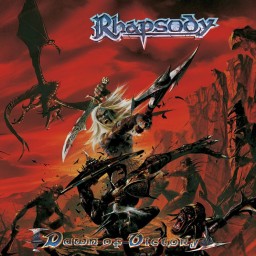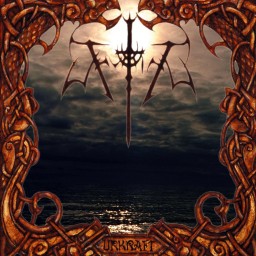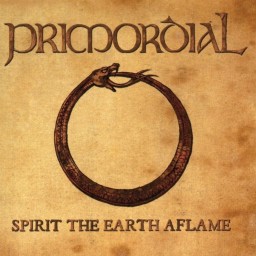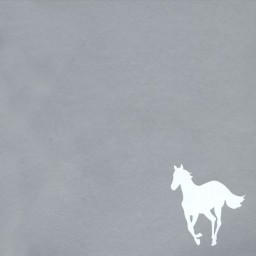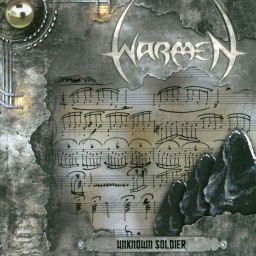SilentScream213's Reviews
Divine Intervention has remained not only my favorite slayer album, but my favorite album of all time since I heard it in my freshman year of high school, 2010. Not that it immediately became my favorite album upon first listen – no, this is a slow grower, but a very easy album to come back to. And come back to it I did, many times; I’m sure this is in my top 10 most listened albums of all time, and a certain contender for the #1 spot.
But, why Divine Intervention?
Why the album AFTER Slayer stopped being the greatest Thrash band in the world? After the lineup change and the death of metal in the 90’s? The album with troubled production and almost no live representation?
Quite frankly, because I don’t give a damn about any of that stuff.
I speak with utmost sincerity when I say I think this album is absolutely as great in every department as the 5 preceding it. The only exception being that the production is lower quality, but you know what? That higher class sheen on Seasons in the Abyss never did it for me as much as the raw, honest sound that we get here. The complaints about the production quality are completely unfounded if one enjoys Show No Mercy, or Kill ‘Em All, or basically any Black Metal.
With sufficient clarity on why none of this album’s “weaknesses” bother me, let me now express why I love it so much.
The mood. The atmosphere. The writing. Slayer were always that too evil band that were somehow mainstream. From day one they were writing about Satan, demons and infernal hellfire, and they remained consistent in that approach throughout the 80’s, with growing themes of real horrors as well, including war and mental illness. However, on Divine Intervention, hell froze over. The hell fire faded and the demons gave way to a much more terrifying being – humanity. Strongly influenced by literature about serial killers as well as newspaper articles, Tom Araya took a stronger writing role here and focused almost exclusively on real world evil and suffering. Songs took a deeper look into the psych of serial killers, criminals, and even drug abuse on the closing “Mind Control.” The riffs followed suit, and as such, this album isn’t as flashy as their previous material, and I think that gets lost on a lot of people. The riffs here are cold and calculated, evoking sincere darkness and an unrelenting bleakness that remains consistent throughout the entire album.
Which leads to an immense strength of this album; the songwriting. Hints of Tech Thrash break through in many of the tracks here, with less conventional rhythms courtesy of Paul Bostaph taking the songs into twisting territory that deviates far from their simpler punk roots. The guitar solos on this album are actually good, and more often than not add to the song with more thoughtful melodies as opposed to pure chaos. The title track and closing track both have perhaps the best solos by the band, and truly these songs felt like they had gained a level of maturity and depth in their structure. Tom’s vocals are also the most aggressive, manic and eclectic he has ever laid to record; in title track “Divine Intervention” he pushes his yelling to its limit, and haunting “Serenity in Murder” allows his lower registry to croon wickedly between more thrash roars. Divine Intervention could easily be argued to be Slayer’s heaviest album, which cannot be said for most metal releases from bands that were “declining” in the 90’s.
At the risk of sounding crazy, I’ll also confess that the insanely dark lyricism and mood on this album, particularly on tracks like “Killing Fields,” were immensely helpful for me emotionally. Since I discovered it, Metal has always been an extremely cathartic way for me to deal with negative emotions. Divine Intervention did that better than any other album I’d heard, and still remains one of my weapons of choice when I need it. People don’t usually label Slayer as being emotional music, but they probably forget that anger is an emotion. Some people have their OK Computers, some people have their Dark Side of the Moons, and I’ve got my Divine Intervention.
Genres: Thrash Metal
Format: Album
Year: 1994
A volte-face to anyone who thinks Doom Metal can’t be energetic and exciting, and a great lesson in what makes true Doom a completely different beast from Trad Doom. Wish I Could Dream It Again is one of the earliest true Doom albums, having zero Sabbathian influence, none of the 80’s Doom groove, and a total focus on somber, melancholic atmospheres. And unlike most prior Doom bands, it doesn’t rely on being consistently slow to achieve this. Lethargic, doomy sections still run through the compositions, but a lot of this material is lively, especially the rhythm section. Simple melodies and morose chords permeate the songwriting, but that drumming ensures a complex and ever-changing foundation to the music.
Novembre also have very melancholic lyrical themes, sticking to the introspective and poetic, drawing upon aquatic, summery and warm imagery across the album in another first for Doom Metal. The sentimental mood here was pretty unique at the time, but the general melancholy on display became a staple for the genre. Doom bands had already begun adopting this focus on gloomy atmospheres, which is how true Doom was born in the early 90’s, but Novembre here upped the ante. This was probably the most melancholic metal album at the time of its release.
As debuts can be, it’s a bit rough around the edges in some places; the clean vocals in particular are quite amateur, though they don’t bother me at all because they perfectly encapsulate that morose feeling of Doom. Either way, a landmark release for the genre, and a great learning experience for those who aren’t privy to the great variation that can be found in Doom Metal.
Genres: Doom Metal Progressive Metal
Format: Album
Year: 1994
If I had to pick one song, not as my personal favorite, but as the best piece of music – one that pulled from all aspects of what makes music such an mazing and beautiful art – it would be Art of Life. As pretentious as that sounds, and as pretentious as writing a 30 minute epic about life may be, this song can actually back up such a monumental title. Am I biased as a metalhead, a fan of X Japan? You bet. But I only love these things because of what they offer me. Metal, to me, is ultimately an incredibly raw, even bestial display of human art. The harshness and aggression of it feels like a death throe. When one is in a life-or-death situation, or pushed to their limit, or faced with overwhelming emotion or psychological trauma, the ugliest, yet purest expressions surface. This is what Metal is to me.
X Japan do a fantastic job of mixing into that Metal foundation the sonic embodiments of young love, of beach sunrises, city-lit snowfall, a tear of joy. They have mastered both the ugly aggression and the passionate beauty, each in excruciatingly pure form. “Art of Life” is their magnum opus that displays every talent they’ve mastered. At times the music gets insanely fast as the guitars and drums exercise every last shred of pain, and at others slows to let the piano and strings cover you like a gentle rain. The song goes to all extremes and everywhere in between.
The lyrics are poetic, evocative, and hold an immense amount of depth especially for a band writing in a second language. Band leader and main writer Yoshiki was going through the grief of losing his father, among other things in his life, and in his words, tried to draw from every emotion he had when writing the song. And yeah, he succeeded, without a doubt. This is conveyed both in the music and the words, which tell of an existential crisis of love, longing, and loss. The lyrics are not specific enough to pigeonhole the song, and therefore almost anyone could listen to this and attach a very personal meaning to it.
Lastly, I’ll talk about that piano solo. That god damned piano solo. Originally, I hated it. I didn’t get it, I didn’t respect it, I didn’t think it contributed to the rest of the song, nothing. I went out of my way to make an edit of the song that cut it out so I could listen without having to fast forward through it. I didn’t get it.
I do not like when people chalk someone’s dislike of something up to them “just not getting it.” As if a song is so transcendental that a human cannot understand it. As if one has to be “in” on something to judge it correctly. As much as I do not like that and do not think it is a good response to any sort of opinion, I will allow myself to say it just once, for this piano solo. I get it now. After going through a psychological and emotional low, I got it. It became so clear what Yoshiki was feeling as he hit that cacophony of keys, how it played into the rest of the song, what it represented, everything. And magically, I immediately started enjoying it. I absolutely cannot listen to the song without it now. It took an experience and a perspective I did not have before to grasp it. And while this is no fault of any listener and I would not wish it on anyone, if you haven’t had that sort of experience, you just might not get it.
Genres: Power Metal Progressive Metal Symphonic Metal
Format: EP
Year: 1993
Bullhead is usually considered Melvin’s first truly great album. The Sludge Metal pioneers are relatively peerless in this era, as you could count the number of notable Sludge bands on one hand when this dropped. These circumstances made Melvins kings of the movement by default, and I think that’s why it doesn’t really appeal to me.
Bullhead is an album that is special by circumstance, because it had no competition and no comparison. It was influential and unique, but those things don’t matter to me when I’m listening to it. The music itself is very basic, monotonous, and droning. These qualities can be fine when done right (or if that is your taste) but I feel this album just doesn’t have enough going on to warrant much entertainment out of that. There aren’t any great riffs, no striking vocal performances, no rhythm grooves, its just a lot of repetitive heavy chords. It’s slow, but it’s certainly not doomy, because there’s no atmosphere and no strong mood aside from kind of anxious.
Unfortunately I have yet to find much enjoyment out of early Sludge, and this album was not the one to change my mind. Onward we go.
Genres: Sludge Metal
Format: Album
Year: 1991
Sometimes when you listen to one of these acclaimed albums and don’t like them so much, you can still see what makes the album so great. You can recognize what other people see in it and write it off as just not being your thing. But sometimes, you might just be left mystified, wondering “What am I missing?”
Just before Streetcleaner, I had been listening to Peter Gabriel’s Passion, one of his most revered releases and a widely acclaimed New Age/World Music album. The album didn’t do anything for me, mostly because I’m not a fan of the style of music. However, I could still acknowledge the great compositions and brilliant atmospheres crafted in the soundscapes, and it was no mystery to me why it is so well liked.
Streetcleaner is a different case. I love metal. I love dark, misanthropic, heavy music. But listening to Streetcleaner, I struggle to find any appeal at all. The songs are all incredibly simple, and it sounds much less like a performance and much more like each member came up with one loop and just had it repeat for 5 minutes. There’s nothing innately wrong with this, but if you’re gonna repeat something for so long, at least make it good. The riffs are barely there; boring, slow, uninspired guitar that does little other than add a sludgy atmosphere, and ditto for the bass. The drum beats are equally boring and uninspired, and aside from some occasional addition of double bass, never do anything interesting. The vocals are sometimes there, and that’s all I can say about them.
The album is certainly dark, but the problem is that it is not active in achieving this. All the music is incredibly passive, and by that I mean there’s a lot of nothing going on aside from sounding heavy and dissonant, and it becomes the listener’s job to project any actual mood to it. The music doesn’t invoke anything on its own, but rather acts as a pool to collect such projected feelings. Unique at the time, and influential for everything that came after… but I’d say this is another case of influenced far surpassing the influencer.
Genres: Industrial Metal
Format: Album
Year: 1989
South of Heaven was my first favorite album. The first one I ever listened to while thinking “god damn, this is music for me.” I had never heard sincerely dark or heavy music before that, and I never looked back.
It all started with my first videogame, DOOM. I played that game when I was just 2 years old – I worked the gun while my father did everything else, but it was still an incredibly memorable experience that was burned into my memory. I didn’t play the game for a long span of time because we had to get rid of it after Columbine happened, and then it became kind of a pipe dream to be able to play it again.
It was actually right as I was entering public school in 8th grade (I was homeschooled prior) that we managed to get the game again. Man that was a triumphant moment, and the game was just as great as I remembered. However, one thing that struck me was the music – holy hell, that music kicked ass.
I wasn’t even into music yet at this age. I listened to The Beatles, I listened to whatever the parents had, and I didn’t really listen too intently. I didn’t even know what metal really was, other than hearsay. But I LOVED this game’s music. I went to shady websites to download mp3s of the game tracks, and naturally, I started reading up about it more. Well it turns out a ton of the tracks are based on real songs by real bands – all metal bands I had never heard of save Metallica. I had to get this stuff.
I actually downloaded all of the original songs without listening to any of them first, bought my first mp3 player, and then listened to them all at once. It was a rite of passage of sorts. I loved everything I heard, even the gruff stuff like Pantera, who’s vocals were too much for me but the riffs were good enough to get through it. This new form of dark, aggressive music was striking all my chords, even though I had no experience with it. But at the end of the list – as the bands were in alphabetical order and there were only 10 or so – was Slayer.
Slayer hit different.
The three songs from DOOM were “South of Heaven” “Silent Scream” and “Behind the Crooked Cross” and they instantly became my favorite songs (barring “The Long and Winding Road", which will never not be one of the most beautiful songs ever). Such condensed aggression and evil had never struck me in aural form like that before. I mean, even Pantera, who were just as heavy, didn’t sound nearly as dark and evil as this. And the lyrics! Holy hell, they were actually disturbing at that age. A song about abortion – what the hell was that. And I loved them.
Finding that the songs were all from the same album, I got it immediately – digitally, physically, everything. I didn’t even know what riffs were before this! This was insane to me. The whole album was just as good as the few songs I’d heard. I easily listened to it at least once everyday for probably the rest of that school semester. And it ended up being really important in me finding my identity in a crucial period of life – I now knew that metal was my passion. I knew what kind of music I liked, I could talk about it, I met people through it, and I searched for more.
The funny thing is, though Slayer remains my favorite band, their other material didn’t click with me at first. Turns out this album was Slayer at their slowest and most melodic; if I started with any other album, I may not have been infected so easily. But yes, it was South of Heaven that turned me into a full-time metalhead, and it was the first album I could confidently say was my favorite. Listening to it while writing this review, I’m not surprised in the slightest that it gives me the same feeling of intense bliss as it did nearly 10 years ago, still comfortably sitting among my favorite albums of all time.
Genres: Thrash Metal
Format: Album
Year: 1988
At exactly 19 seconds into this album, you can feel what it's like to have your skin melted off your face from the inside out.
What the fuck are you waiting for?
Genres: Thrash Metal
Format: Album
Year: 1986
I’ve always loved Slayer, this album being among my favorite releases by them, but it becomes so much more amazing when compared to the contemporaries at the time. Absolutely nothing was this insane – not even close.
Speed? We had Metallica, but they’d only go into overdrive on a couple songs – and even then, it never matched Slayer. Tremolo guitar picking has never been this fast. And Dave’s drumming was something else. The speed and technique of the drumming here had never been seen in metal before. I’d guess only some Jazz and the best Prog Rock drummers had the level of chops Dave put on this album back in 1983.
Riffs? Hell no. You think Paranoid had great riffs? Number of the Beast? They were all lacking something. Slayer doesn’t just deliver riffs – they deliver evil riffs. Wailing, screaming guitars walked the line between melodic and chaotic, bringing a perfect harmony of very catchy riffs and a dark, harrowing mood. No music sounded this dark and melodic at this time; any other bands attempting the evil schtick relied on purely being noisy and chaotic with little technique (Venom, Hellhammer).
And then there’s the vocals. Not just the style, but the delivery. Tom’s trademark yelling here has become something often imitated, and I daresay it was many people’s introduction to harsher vocal styles. Tom was not the first to employ a harsh vocal style (Venom, Black Flag), but he absolutely did it better than anyone else at the time. He brought just the right amount of melody to the table; he can hit notes, and his words are very intelligible. Despite that – or perhaps, because of it – his bark comes off as much more convincing. As opposed to the flat screaming or growling of bands like Hellhammer and Venom, you could discern emotion in Tom’s voice, and that emotion was anger, hatred, a general misanthropy and dedication to the dark arts. That delivery carries over to the lyrics – again, Slayer were not the first to write Satanic lyrics. Venom mostly started that, but they didn’t take it too seriously. Slayer, along with King Diamond, were really the first band to convince you that those lyrics about Satan, murder, and black magic were genuine. Of course they weren’t, but damn was Tom’s fierce, rabid bark convincing.
Back in 1983, there were absolutely no albums that matched this. Any other album that had traits of what makes this great was missing something else, whether it be the speed, aggression, technique, or mood. Slayer was the first band to unite these qualities in a way that would spawn a staple style of dark metal carried on by thousands of bands.
Even after listening to hundreds of albums that were released pre-1983, Show No Mercy remains chronologically my earliest 5-star release, and nothing up until that point in music has come even close to instilling in me the sense of awe as Slayer did with their debut.
Genres: Speed Metal Thrash Metal
Format: Album
Year: 1983
Probably the angriest album ever recorded. Definitely Slayer’s most vulgar, as well as their poorest lyrically, with way too many songs dedicated to “Fxck you, I’m gonna fxck you up, you better get the fxck out of my way.” It’s probably my least favorite Slayer record aside from their covers album for that reason. Although, another important reason would be how rhythmic it is; the band’s clearest foray into Groove Metal, and their most uninspired riffs go hand in hand with their most generically juvenile lyricism. I don’t hear the Nu Metal seasoning that many others seem to claim, but it’s definitely got a stain of “Modern Metal” on it. Many of the songs here don’t have any super iconic riffs, which is an absolute sin for any Thrash band. Even Diabolus, which I find much more underrated, did much better at crafting dark moods at the least, even if some of the riffs were similarly lacking a bit. Tom’s got a bit more production layered on his vocals here too, which in my opinion he doesn’t need and they just make him sound worse.
Why the high rating then? Cause at the end of the day, it’s still fxcking Slayer, the best fxcking Thrash band on the fxcking planet. “Disciple” is probably the angriest, most misanthropic anthem ever recorded, Araya going above and beyond delivering an intense vocal performance that is simply awe-inspiring in its aggression. “Deviance” is one of the bands most ominous and unique sounding songs ever, with a slight Gothic edge and unnerving double-tracked vocals delivering deeply disturbing lyrics. “Here Comes the Pain” is a slow build packed with power, whereas “Payback” has all the intensity and hate of aforementioned “Disciple,” all directed at a single person.
It's definitely got the most filler of any Slayer album, but even then the songs are still great. “Cast Down” fails to deliver any truly memorable riffs, but it’s incredibly unique in having one of the most somber and “real” themes in Slayer’s discography about the struggles and despair of drug addiction. “Bloodline” similarly lacks much musical punch, but is one of their catchier numbers, as “radio friendly” as this band got with a simple music structure, a focus on the chorus, and lyrics about vampires (which just barely precede the boom of vampirism in pop culture.)
So sure, it’s one of Slayer’s worst albums, but it’s also still Slayer fxcking shxt up like they always have, it pumps me up and melts my skin off, it’s got more intensity in it than most bands have in their entire career, and there is no better album to reach for if you just need pure, unfiltered rage.
Oh yeah, and it was released in 9/11, so that’s just one extra “fxck you” that comes with the package.
Genres: Thrash Metal
Format: Album
Year: 2001
My Dying Bride have had many twists and turns in their discography, but despite that, have always remained connected to the Gothic Doom sound, and have also been quite consistent in their career. They’ve got multiple albums that are viable picks for the band’s best, and while I personally wouldn’t pick The Dreadful Hours as my favorite MDB record, I would say it’s the best representation of the band and their career out of all their releases.
After having experienced old school Doom Death, true Death Doom, Gothic Doom, and even some experimentation with Alternative Metal influences in the 90’s, the turn of the century sees the band settle very solidly on their apex Gothic Death Doom style. Every song here is long, dreadful, and contains many varying passages and intricate song structures. While the style is consistent, the variety within said style is quite nice, with funereal plodding dirges, energetic belays of tormented grief, and softer atmospheric moments of quietude. The album is riff-oriented, but has a great amount of soundscapes layered beneath the classic metal ensemble, from strings and synths to choral arrangements.
The songwriting is the most impressive aspect here to me. The songs progress seamlessly between different sections, and seem to know exactly when to throw in a burst of energy, or a quite reprieve of peace. I think the band have written better riffs and melodies, but the song structures here are probably the best of their career. It says something when you can manage most songs exceeding 8 minutes and none of them have any boring parts.
The only weakness here is that the songs have a distinct lack of hooks, particularly in the realm of lead guitar or vocal melodies. With one or the other, the songs would have been elevated and much more memorable on their own, but Aaron sticks to an (appropriate, but admittedly samey) monotonous croon and the guitars stay mostly at the bottom two strings rather than layering some identifiable melodies over the riffs.
Quite a fantastic record that serves as an iconic template for Doom in the new millennium and a perfect profile of My Dying Bride’s long career.
Genres: Doom Metal Gothic Metal
Format: Album
Year: 2001
Poets and Madmen is Savatage’s swansong and in my opinion, their most underrated work. Jon Oliva returns for sole vocal duties on this album, and I personally am thrilled. As great as Zak is, Jon is simply my preference due to his much rawer, aggressive yet passionate delivery. The album is still a concept album in line with their recent works, but a bit looser and less… pompous, let’s say. It sounds like a good old fashioned Heavy Metal record.
The compositions here are undoubtedly among the best of the band’s career. There are riffs for days – both on guitar and keys, and no shortage of memorable vocal lines either. The songs are quite progressive in nature, shifting tempos often and packing each track with a great selection of riffs and rhythms.
More striking than that though is the emotion. There’s anger, pain, melancholia, and a bit less hope than most Savatage records. This one stays pretty strictly in pessimistic, almost apocalyptic territory, lamenting the state of the world both globally and personally. It culminates in closing track Back to a Reason, which is in my opinion the finest song the band ever wrote, evoking intense emotional passion and desperation across 6 minutes of melodramatic progressive epic.
It’s not as flashy as the Zach era and it’s much more somber than their earlier works, but it’s a magnificently written album that closes out their discography perfectly. Also, classic Heavy Metal this good in the year 2001 was extremely hard to come by; Savatage sticking to their roots and dropping this was a great move and gave future bands a worthy template for the new millennium of Heavy Metal.
Genres: Heavy Metal Progressive Metal
Format: Album
Year: 2001
Considered Sodom’s modern masterpiece and arguably one of the pinnacles of modern Thrash (as long as modern still means anything after the 90’s). M-16 is one of Sodom’s most unique albums in that it’s a concept album about the Vietnamese War. It doesn’t exactly follow a distinct storyline, but each song touches on different aspects of the war.
Another way this album is unique is in how it has a surprising amount of restraint. Sodom have always been one of the heaviest Thrash bands, commonly flirting with extreme influences like Black and Death Metal, and even when not, delivering some of the most aggressive, bone-shredding Thrash out there. M-16 is surprisingly tame for the band’s standards. While the vocals remain just as aggressive, the guitars and drums are heavily tempered in their aggression, in fact often settling for a style akin to more traditional Heavy Metal when they aren’t delivering classic Thrash. This seems to have made the album more accessible to a wider audience, as the most popular songs here are the least thrashy (Napalm in the Morning and M-16).
However, what does that mean for a hardcore fan? While I do find this album fantastic, I certainly don’t rank it among the band’s best. Slowing down and playing more accessibly is the last thing I want from Sodom. Songs like the masterpiece “Canon Fodder” prove the band is as capable as ever at writing and delivering their signature style of no-holds-barred extreme Thrash, but I’d much rather have a whole album of that then the flirtations with slower, softer styles found here.
And they end the album in the absolute worst way possible, with a terrible, goofy, Crossover Thrash cover of a terrible, goofy song.
The concept elevates the album a little bit and the playing and songwriting is as good as ever. But the style shift is not what I expect or prefer from these guys. It’s an amazing album in the grand scheme of things, but among the discography of one of the titans of Thrash, I find it just average.
Genres: Thrash Metal
Format: Album
Year: 2001
Moonsorrow was a band I had extremely high hopes for after hearing their “Tämä Ikuinen Talvi” demo. The word “demo” does a terrible disservice to this release because not only is it long enough to be a full length album, it’s also so well written, played, and composed that it could be a band at the top of their career. The production isn’t bad either!
By their sophomore album, Moonsorrow had improved in many areas. The production, of course, was at a polished, professional level, and the mix sounds perfect here. The dense yet restrained orchestration is fantastic, the layering of numerous folk elements adds intrigue and aesthetic. The playing is of course more precise. The progression of songs also feels very strong, often featuring well-earned rests and crescendos.
The issue is, in my opinion, they regressed in terms of capturing mood. Or perhaps, it’s better to say, they moved away from the kind of mood I personally prefer. While their demo had a darker, more somber feel (as a band called Moonsorrow should) they had since gone towards the direction of more epic, uplifting, and unfortunately jovial sounding tracks. At the worst of times, the instruments and melodies can sound silly even.
I mean, the 3rd track “Kylän Päässä” prominently features boing boing noises, sounding like a goofy cartoon medieval villain’s theme song.
“Hiidenpelto” is where they get back into the territory I like. That is, dark! Sorrowful! Yet still retaining that incredibly epic, folky feel of grand medieval adventure. This is what I had hoped they would evolve into. The song has a fantastic mix of slower, doomy sections and aggressive energy, and features an instrumental outro with a build up and crescendo that is just sublime. Probably the best song the band has ever wrote.
And then the next song opens up with more boing boing noises. Despite how well written and layered this music is, there’s the simple fact that I just cannot take some of this stuff seriously. Aside from the egregious “instrument” choices, there are melodies here and there that just sound too… playful. Not what I want from a band called “Moonsorrow.”
That’s not to say the album isn’t great, because it is. There are only so many points you can lose when music is this perfectly executed. The sheer force of these tracks is awe-inspiring, the way they totally encompass you in their atmosphere and take you to another time and place. Undeniably amazing album. I just wish they kept their darker sound… in which case, this could have been a masterpiece.
Genres: Folk Metal Viking Metal
Format: Album
Year: 2001
One of my first albums. I grew up with this thing, it was part of my formative years in middle into high school. Most of the songs evoke memories of bus rides, of seeing the same friend group every day, of walking around town with nothing to do. Actually, Toxicity was one of the albums my friends and I could agree upon; I was pretty strictly into 80’s and 90’s Metal at the time, whereas they were much more Deathcore modern scene kids, but Toxicity, we could agree, was awesome.
That’s not to say I am blinded by nostalgia; in fact, I will go on record to say this album is vastly overrated. One of the main reasons being its inconsistency. It’s got some amazing highlights that even people without a clue or care about this band can enjoy (Chop Suey!, Aerials). The title track has some of the most iconic drumming in the history of music. But it’s got just as many tracks that fall into… “filler” seems a bit too harsh, because every track is very unique and memorable, but just… not as good territory? They aren’t nearly bad songs, but I don’t have much desire to revisit “Prison Song” or “Jet Pilot” again.
The songwriting on this album is really interesting. Could never say for a second that a single moment of this album is boring. And each song is absolutely bursting with character. The amount of personality oozing from each band member is cartoonlike in its audacity. Yet at the same time, some of the compositional choices are just odd. I mean, purposefully so, but that doesn’t make them good. Some of the jerky or disjointed start-stop tactics or odd mood shifts sound “quirky for the sake of being quirky” and at worst pull me from the enjoyment of a song. The aforementioned “Prison Song” as well as “Needles” are guilty of this, with their calmer, catchier sections really not meshing well with the heavier ones. “ATWA” on the other hand, averts this magnificently, but there’s a reason; the song stays consistent in mood, detailing the thoughts of a paranoid maniac tormented by their own thoughts, and so the somber, softer sections exploding into heavy dissonance make sense thematically and compliment each other perfectly.
SoaD was super influential as a band, and this was far and away their most influential and iconic album. History has also been very kind to it, whereas there was a time when “trve” or “kvlt” metalheads disavowed it, it’s almost universally beloved now. Too much so, in my opinion. An album as quirky and inconsistent as this seems out of place holding accolades such as… I dunno, anywhere near the top 10 Metal albums of all time? It’s a great album, but this is one I’d rather reach for the highlights and not play the whole thing front to back for another 10 years.
Genres: Alternative Metal
Format: Album
Year: 2001
I started listening to this album right when the Oblivion remaster dropped, and let me tell you, there could not be a better match. On this album, Summoning combine the cheesy, medieval Dungeon Synth reminiscent of games like Runescape with their signature Atmoblack guitar compositions. Vocals shift between classic Black shrieks and epic sounding samples.
Listening to this wonderfully evocative album as I return to the familiar world of Cyrodill was a seamless union. The martial drums beating as I slaughtered adversaries in the arena, the lush and affectionately dated synths adding to the intrigue of discovering ruins, the overall majesty of fantasy of both pieces of media melding into a perfect combination.
The layering of this album is the real treat. Most of the instruments – both synthed and real – are playing simple and repetitive chords or melodies. Nothing too impressive on their own. But weaved in between the synthed horns, guitars, and drums, are a plethora of other synthed instruments, resembling anything from old medieval instruments to more modern electronic sounds. There’s a lot going on and it justifies the simplicity.
What I will say though, is that it makes a better soundtrack than it does a focused listen. One big weakness is that while the album succeeds immensely at evoking a medieval, fantastic atmosphere, it doesn’t evoke any emotion at all. It’s not sad, it’s not happy, it’s not angry or evil. And thus it works well as background music, but loses a bit as a unique piece of work due to its lack of mood. Throwing in an angry or melancholic track here and there would make it flow more like a movie rather than a static backdrop to a castle. It’s also exceedingly repetitive and low-tempo most of the time, which can get a bit tiring. The previous album did a better job of incorporating a bit more… Metal.
Still though, wow. It succeeds at doing exactly what it wants to do. All fantasy all the time. Definitely worth a listen for anyone remotely interested in the aesthetic, and my personal recommendation as a makeshift soundtrack to any fantasy game.
Genres: Black Metal
Format: Album
Year: 2001
Tool is a band I’m not particularly fond of. There is the fact that everyone seems to love them – including non-Metalheads and people not normally interested in progressive brain music or however you want to say. It’s odd to me, how many times I’ve met someone who doesn’t like heavier music, “but I like Tool.” Especially considering they aren’t exactly… accessible. They top charts across multiple websites, Metal-centric and not. They get radio play, yet at the same time have a fanbase of some of the most esoteric music aficionados on the planet. They are a weird enigma, and I suppose that suits them…
My gripes with their status aside, none of that affects my own personal thoughts on the music. And for this album, Lateralus, the music is… Good. It’s quite good. Many of the tracks are actually really great. “Schism” is the hit, and for good reason; it combines every strength the band has into one elaborate track. Quiter, contemplative sections lead by odd-time rhythms explode into heavier crescendos; passionate, allegorical lyricism delivered in a fit of desperation sets a scene and mood that strikes too close to reality; and it’s all tied together by one of the most iconic music videos of all time (which normally don’t interest me, but this one… is an exception). “Ticks and Leeches is a personal favorite of mine, showcasing the band’s more aggressive and angry side, and having some of their best riffs (Tool isn’t really a riff-oriented band, so hearing them do it well here is a treat).
At the end of the day though, the album still suffers from the biggest problem all their albums have; it’s bloated, overlong, and has vast boring sections. Lateralus is, without a doubt in my mind, their best album - the highs are mountainous, and the filler space is a bit better at crafting some contemplative atmosphere than most of their output. But still, the album as a whole to me is… just quite good. Not great. Would never be anywhere near the top of my all-time list, my 2001 list, my Prog Metal list… and again, this is coming from a metalhead, who loves Prog Metal. I will give accolades to this album where they are deserved, but I will never understand the world’s obsession and adoration for this band.
Genres: Alternative Metal
Format: Album
Year: 2001
After having found their style on Theli, Therion have not only maintained their key Symphonic Metal style, but continued moving towards making their composition grander and more operatic. Almost every song here is led by choral vocals from multiple vocalists, layered in a way to deliver power and grandeur. Symphonic elements actually aren’t as prevalent as one might expect, providing more of a backdrop of smooth layers while the choral vocals take front and center stage.
While the compositions have become more dense and epic, in my opinion, the core Metal instrumentation (Guitar, drums, and bass) have suffered a bit. There are some nice guitar leads that sound Gothic influenced, and decent riffs here and there, but overall the album relies a bit much on the choral vocals. Another problem there being… it just sounds a bit too happy? Or uplifting, I guess. Yeah, there are darker parts to the music and lyrical themes, but choral vocals are layered in a way where they sound more religious than dark or ominous. Just doesn’t work for me too well.
The concept of the album revolves around the nine realms of Norse mythology, and each song has a significant identity due to this, as both lyrically and musically the compositions work well to embody the different chapters and landscapes. Anyone interested in said mythology or concept albums in general should appreciate the work there.
At this point in their career, Therion have an undeniable level of quality that goes into every song. For me personally, I’m simply not in favor of the direction they’re going, completely abandoning their dark extreme Metal roots in favor of more lighthearted, uplifting, vocal-driven compositions.
Genres: Symphonic Metal
Format: Album
Year: 2001
The debut album from Sweden’s Lost Horizon sounds more like an experienced band at the peak of their career. How they managed to compose and record something with such astute quality right off the bat is a mystery to me.
Many people have lauded the album for being one of the MOST Power Metal albums ever recorded. Indeed, Lost Horizon go above and beyond in every aspect of their delivery. The guitars are wild, speedy and neoclassical, melding aggressive riffing with fantastically melodic leads and solos. The drumming is ever changing and technical, taking a lot of progressive influence and incorporating it into classic, thunderous Power Metal blasts and gallops. The bass is surprisingly excellent and audible, grooving up and down the fretboard like a third lead guitar to add another layer of melody and progression. And then of course there are the vocals; an over the top, melodramatic call to arms filled with just as much power and force as they are with melody. The only thing missing are dedicated keys… but the four piece are so strong that they make you forget that more often than not.
The meat of the album is the perfect mix of what makes Power Metal good, and many of the songs have no flaws to speak of. Exceptionally well-written, expertly performed, memorable, strong, catchy, pummeling, triumphant… the list of what this band does right goes on and on.
I have to come to one of my pet peeves though. Useless interludes. The album has three of them. And at ten tracks and 44 minutes, 3 of those tracks and 4 minutes of the runtime being interludes hurts. While one is a decent New Age piece, the other two are really bad Ambient Drone tracks. Just, why? Why do bands do this? Lost points there.
It lives up to the legends, otherwise. A phenomenal piece of work., and amazing debut album.
Genres: Power Metal
Format: Album
Year: 2001
“Sonic Excess in Its Purest Form” is probably the most accurate album-title-description of the music therein that I’ve ever come across. Crowbar has done exceptionally well continuing to play old school Sludge and keep it top quality without changing their sound much with the times, and this album is just more of that. Plenty of Doom influence, some occasional seasonings of Groove and Metalcore, but otherwise pure, old school Sludge.
This is an ugly and dense slab of audio, focusing on themes of drug abuse and addiction, depression, self-hatred, all the classic Sludge Metal fair. There are bursts of manic energy which add great dynamics to the album, but much of this Sludge is slow and doomy. It sounds like getting buried under fresh concrete. Most of the music is simple enough, relying on the sheer heaviness to deliver, but the guitar has some really great riffs and leads that make the songs quite memorable for the genre.
My favorite part of this are Kirk’s desperate, dirty vocals. They’re absolutely perfect for this style, and I’d rank him among my favorite harsh vocalists. There’s so much emotion in his wretched snarl, and he holds notes despite growling like a cornered animal. The lyrics combine with the vocal performance to flawlessly deliver the pleading cries of someone who’s been down too long and is partly to blame for their own misery.
It's not perfect, though. The songs that lean more into Groove or Metalcore territory, that is being more rhythmic instead of moody or melodic, are weaker. When the band focuses more on just being heavy and chuggy, it gets a bit… boring. Unfortunately, that’s slightly under half the tracks. I would say the highs here are the band at their best, at least up to this point, but as a full album, it’s not the masterpiece it’s made out to be. Earlier releases such as Time Heals Nothing and the Self-Titled album are more consistent quality-wise. Still, one of the best examples of Sludge Metal you’re going to find.
Genres: Sludge Metal
Format: Album
Year: 2001
Spirit Caravan dropped two albums before disappearing into the smoke, and both are considered quite respectable pieces of Stoner Metal (some call them Doom Metal, but there is no Doom Metal here). As with their debut, Elusive Truth doesn’t set out to reinvent or even add anything new to the genre, instead carrying on the tried-and-true formula spawned by Sabbath back in ’71.
The problem is, that sound was boring in ’71, and it’s still boring 30 years later in 2001. As far as Metal goes, Stoner Metal is one of the laziest and most passive genres, and “Elusive Truth” is a perfectly average example of the genre. Unremarkable vocals, riffs that evoke nothing, and drumming that is simple and monotonous. Who knows if the bass is even there.
Positives? Well, it’s still a decent album. If you just wanna throw on some groovy Metal, it gets the job done. There’s no emotion to it whatsoever, so you don’t have to worry about it affecting your mood. Could work well with an open window drive on a muggy summer night. It’s never offensively boring or anything, I have more of a problem with people claiming this to be some holy grail than I do with the actual album (which is average).
Again I should reiterate the album is fine enough. If you LOVE Stoner Metal, this should be more than good enough for you. For me though, Spirit Caravan are simply a band I would have lost absolutely nothing had I never heard them.
Genres: Doom Metal Stoner Metal
Format: Album
Year: 2001
Pig Destroyer proceeded to copulate with their instruments like objects of hate and affection. The sounds were ugly and unique and fascinating. Blood flowed freely as flesh scraped against splintered wood and metal wire. It was an awful sight. It was the sight of a crimson sunset staining the erect towers of concrete tombs. It was the sound of waves scraping away sand from the body of a beach. It was the taste of metal, red metal, innocent red metal, at least it was until about 5 seconds ago before it came flowing out. It was so horrible that it turned inward on itself until its innards were borne, a beautiful garden of twisted flesh and bone. The sounds were satisfying and fulfilling and gratifying. What a beautiful city. Where is this beach where girls in bikinis write their names in the sand. Their lives extinguished before the waves can even wash away the letters. But then, they never have to see the day they stop being beautiful. Or were they never.
Genres: Grindcore
Format: Album
Year: 2001
A surprisingly Gothic affair from the kings of Neue Deutsche Harte. While retaining the rhythmic four on floor patterns and simple anthemic structures, Rammstein integrate Gothic and epic atmospheres into their songs. The extra layers add more power, but also a smoothness that the expert production does a great job of layering. The atmospheric depth definitely help alleviate the weakness of how repetitive the songs and structures are in this style of music. Till’s vocals fit quite well with the Gothic sound as well, the natural gruffness sounding right at home.
There is a weakness the new style brings though. The glaring issue are that Rammstein are not an emotional or moody band. Gothic Metal excels at evoking emotion, but when the band isn’t doing that, the genre sounds rather hollow. The result here is Gothic-esque atmospherics being added, without any of the mood or emotion. So, it’s a nice smooth layer of music, but nothing else.
As with their previous albums, Rammstein kind of rely on the listeners enjoying rhythm and danceable tunes. They do a great job of creating simple yet dense songs with tons of finely tuned details under the beats. Yet, the instruments in the forefront, that being the guitars and drums, don’t do much. The riffs and leads are quite boring, and the drumming is basic and repetitive. The vocals are neat, but limited, having decent power, but not crafting any memorable melodies.
Good quality album for fans of this sound. But it has more flaws than an album of such reputation should.
Genres: Industrial Metal
Format: Album
Year: 2001
It must be clarified outright that I’m typically not a fan of Avant-Garde Metal or Experimental music in general. Avant-Garde Metal usually falls into one of two horrible tropes: the first being that Avant-Garde Metal musicians seem to think that Avant-Garde means it’s not allowed to sound auditorily pleasant, as in the music must be dissonant, chaotic, or abrasive in order to qualify as Avant-Garde. The second is Circus Metal.
Leaving Your Body Map is an offender of the first trope. And to a degree, it is both forgivable and understandable; the album is a very dark and surreal experience. It prominently features Doom influence in the sound, and while lyrically very cryptic, there are hints of themes that range from ethereal and innocent to depressing and traumatic. To that extent, dissonance and chaos are not only appropriate but welcome, and help to evoke certain aesthetics and themes that the lyrics prefer to keep concealed behind a layer of mystery and allegory.
The issue is that there’s just not that much to hold on to, or even enjoy at times. Sure, lumbering, dissonant guitar chords with some off-tempo jazz and a flute thrown in for god knows what reason can appropriately convey a certain sense of anxiety or breakdown, and it can even be interesting, novel, and atmospheric, but is it enjoyable? Well, for me, the answer is not always, not if there’s too much of it. I need melody, harmony, and order to balance the dissonance and chaos in order for it to work successfully.
Maudlin of the well, to their credit, do include a fair amount of more melodic material (mostly prevalent in their acoustic interludes), and a great variety of eclecticism in general. The issue there is that, well, the melodies just aren’t that strong. Everything from the vocal lines to the instrument leads fail to carry memorable melodies.
Let’s talk about a positive though, an area in which this album absolutely excels: evoking the dreamlike aesthetic of the surreal. It’s not just the weird cryptic lyricism, sound effects and liminal album art that convey this. Everything about the song structures, from the production and density to the composition style. Often, songs will throw in instrumental pieces or vocal lines that are not clearly audible, being kind of muffled behind the primary wall of sound, that evoke how difficult it can be to properly “perceive” things in the haze of a dream. Another aspect is how the songs will simply do things that don’t make sense; not just the dissonance, but the way individual instruments will play their own piece seemingly ignorant of the others, out of key, out of time, yet bound together just enough to remain musically cohesive. Much as our brain struggles to make sense of the nonsensical nature of dreams, yet tolerating it for our own sanity.
It should also be noted that every range of dream is covered here: the ethereal, the calm, the nonsensical, the nightmares, the longing, the traumatic. The range from full-on pummeling Death Doom to peaceful Chamber Folk is quite a feat.
I really appreciate this album, and am incredibly fascinated by it. I think it’s a bit of a marvel of musical composition and ideas. But, it’s not always pleasant to listen to. And not in the good way, like a really depressing Doom album that I only want to hear to achieve such a melancholic mood. I mean it just straight up doesn’t sound good at times. There is such a thing as too weird, and too many Avant-Garde artists are guilty of catering to that need to be weird over the need to write a good song. Maudlin of the well are nowhere near as guilty as most Avant-Garde artists in that respect, but still enough so that the listening experience of their music is damaged when some slightly more conventional directions could have resulted in a masterpiece.
Genres: Avant-Garde Metal Progressive Metal
Format: Album
Year: 2001
A Sun That Never Sets is a relatively subdued album by Neurosis standards. Not only is it quite slow and doomy, but it also has many sections of very restrained instrumentation where the guitars become quiet. Post-Rock and Neofolk are woven between the grander Atmosludge sections, fostering a more minimal sound. Of course the miserable industrial atmosphere remains, but it is one of the “calmer” Neurosis albums, if you can say that.
Most Neurosis albums have a bit of a theme running through them, and this one has constant ties to nature and the sun (this being the second Neurosis album named after center of the solar system). Although they are rather cryptic, there’s a constant feeling of epic grandeur set to the beautiful planet burning to the ground. Mythological apocalypse style.
On this album yet again, Neurosis fall into the same problem I’ve had with all their albums (Except Souls at Zero which was a masterpiece). They craft some really incredible moments, such as the bagpipe-backed crescendos in “From The Hill,” but the issue is they take forever getting there. The band will mull around with some boring, lethargic riff that doesn’t do anything for minutes before they get to anything good. And some of the songs don’t even have a nice payoff. The album ends up feeling very bloated.
At this point in their career, the band are pros at layering dense atmosphere of industrial sludgy madness, and in that area they never fail. The song are rich and mixed well, with many atmospheric effects only revealing themselves after many listens. This adds a great relisten-ability factor, and helps detract from the, at times, boring simplicity of the main instrumentation.
Still though, most of these songs could have been cut in half, or simply need way better riffs or melodies to succeed. A solid release, but its own meandering holds it back.
Genres: Sludge Metal Post-Metal
Format: Album
Year: 2001
Yeah, they open up the album with blast beat skronking. I already know how this is gonna go…
Or so I thought. Now don’t get me wrong, this still isn’t my preferred flavor of Dissodeath, but there’s a big difference between this and the previous Obscura, that difference being that this sounds like actual music.
While there’s no shortage of annoying skreeonk angular guitar riffs, there are also some “normal” sounding Tech Death riffs thrown in that are quite good. The songs have slightly more natural progression, sounding like composed works rather than 10 second segments of random chaos cut and spliced together. The drumming is more controlled, doing more to serve the music rather than be as wild and chaotic as possible. And lastly, the vocals are a bit deeper, stronger, and better enunciated, a massive boon after the high-pitched bellowing of Obscura pushed my tolerance to its limit.
I was very pleasantly surprised to find Gorguts take a few steps back and head towards a more normal direction on this album. While this still isn’t that good to me, the massive improvement from Obscura could definitely lead to something great down the road if they continue honing this style rather than chasing the next weirdest thing.
Genres: Death Metal
Format: Album
Year: 2001
Unforgivable vocals ruin this. Look, I love extreme vocals. I love death growls, I like Black Metal shrieks, I love Thrash yells, all that good jaunt. And even classically “bad” vocals don’t bother me much. I’ve got a pretty high tolerance for that stuff as someone who listens to more than a handful of Metal bands where one of the musicians basically bit the bullet and did the vocals despite not being able to sing at all. I mean hell, I even enjoy J-Pop/Denpa/Idol music where the singers can’t actually sing at all and rely on autotune and their cute aesthetic to get by. Really, it usually doesn’t bother me.
The abrasiveness of these vocals goes beyond offensively bad, into essentially unlistenable, to the point the music around it suffers immensely. There’s some sort of distortion/static effect on most of them which makes them even worse. The crazy thing? The vocalist employs more than one technique, and they suck at ALL of them. The shrill screams are terrible, the punky yelling is terrible, the sassy vocals are terrible, the “singing” if you can call it that is poor, the only thing passable the vocalist does is the monotonous droning style used on “Phoenix in Flight.” Which still isn’t good, but it’s inoffensive.
I originally wanted to read the lyrics along while listening to see what it was about. Gave up halfway into the first song as the vocalist does not even make the most basic attempt to enunciate a single word. Right from the first line, you are immediately lost, as the noises the vocalist screams don’t sound like even one word in the verse. I will never know whether they are good or not because the vocalist put zero effort into delivering them.
Oh, the music? Maybe I’d have more to say about it if I wasn’t distracted by how awful the vocals are the whole time. It’s competently played and written, even above average for the genres employed most of the time. There are some genuinely great moments scattered about, usually when the band leans more into crafting riffs and chord progressions as opposed to being as mathy and chaotic as possible. “Heaven in Her Arms” has some awesome riffs and chords that walk the fine line between melodic and dissonant, aforementioned “Phoenix in Flight” has nice doomy atmosphere, and the Post-Metal style buildup of the closer is pretty great. The drumming is consistently excellent, and probably the one aspect of it I have nothing but praise for. Not only technically impressive and complex, but also packed with variety, and simpler sections that serve the music rather than being too preoccupied with chaos and showing off.
I’m not going to lie though – even with the perfect vocalist, this album would only be “good” to me. Most of it is too chaotic and angular for my taste. A shame though, I think I would have enjoyed the lyrics and concept. At the end of the day it’s just not for me.
Genres: Metalcore
Format: Album
Year: 2001
A miserable, wretched experience – and that’s exactly what they were going for here. A fully realized Drone Metal album, Khanate use the genre to create some truly hideous soundscapes, wrought with dissonance, noise, fuzz and lethargy. The plodding drums create just enough of a foundation to contain the chaos, with guitars and whatever else being used liberally and dissonantly to create harsh noise. The vocals are another aspect adding to the hostility, being a horrid, raspy yell that delivers ridiculously creepy and abstract lyricism and about saws, skin and bones.
For the right person, I think this could be exactly what they’re looking for. I can understand the appeal, as someone who greatly enjoys the deepest despair brought by the sound of genres like Doom Metal. I will say the album is unique for its time as well; despite Drone Metal being around for some time by the turn of the century, very few bands were actually exploring or developing its sound, especially not as entire identities, which Khanate opt to do.
Unfortunately though, the sound here is entirely unenjoyable for me. It’s too dissonant and noisy, and the worst part is that there’s absolutely no counterplay or depth at all. Every minute is the same as the last, with one song being entirely indiscernible from another. The vocals, while having a certain “scary” intrigue at first, quickly become tiring. The lyrics are similarly boring due to being too abstract and repetitive, almost painting a horrifying picture but instead falling short and looking more like ai generated ramblings. I am thankful it has drums (Drone Metal without drums… really isn’t Metal to me!) but those drums do absolutely nothing. Which would be fine if the atmosphere was better, but it’s way too noise and texture oriented rather than mood oriented, which I strongly dislike.
Not for me.
Genres: Drone Metal
Format: Album
Year: 2001
Each album by Novembre has offered something different in a way I adore. The debut album was classic, no holds barred Progressive Death Doom, and one of the first albums ever in the true melancholic Death Doom style more divorced from the more Death Metal tinged style of the early 90’s. The sophomore release was a much calmer and more Gothic Doom album that focused more on clean vocal delivery and slightly catchier music. Classica is in some ways a combination of the two; a melodic, energetic assault of extreme Progressive Gothic Death Doom with influences of Meloblack and Melodeath for that extra bit of power. And it manags to surpass both albums magnificently.
While Classica has unmistakable touches of that fantastic 90’s Gothic Death Doom style (Katatonia, Anathema), it’s also got one boot firmly in the new millennia. Listening to this album, I’m given nostalgia for the 90’s mixed with what was, at the time, a pioneering transition into a style befitting the new era – which of course now, just means even more nostalgia for me of the 2000’s variant. The lyrics are the most striking aspect that puts me firmly in 2000; cold scenery of artificial light, shadowy hallways and snowy streetlights visible through windows paints a picture of how culture was changing at the time. Whereas the 90’s was focused on being xtreme and fantastic, the 2000’s kind of reigned things in and focused on modern reality, especially suburbia. These lyrics dance a fine line between Gothic Doom poeticism and much more plain realism, and they work wonderfully.
The music of course also works in these transitions. We’ve got the classic stuff; fantastic Gothic Doomy guitar leads, aggressive, progressive Death Doom drumming, great songwriting that works in changing tempos and styles. But it’s also got a touch of newer stuff; some Darkwave sections, real spacey, almost Post-Metal atmospheres, gentle, Dream Poppy vocals, all stuff that were still rare in Metal at the time, but would become more commonplace in the coming era.
The album is incredibly consistent. There’s never a dull moment, no track less than fantastic, and even the instrumental track and outro are very convincing and strong. It’s packed chock-full of melancholy, doom and gloom. It’s also rife with energy and aggression, changes and variation. It’s as crushing and emotional as it is driving and entertaining. Novembre married the best of many worlds together on this album, which I consider nothing short of a masterpiece.
Genres: Doom Metal Gothic Metal Progressive Metal
Format: Album
Year: 2000
Used is an enigmatic album opener that commences with what can only be described as almost spoken-word rapped Nu Metal. Right from there, I was a bit turned off. Not that I dislike Nu Metal, but it was the last thing I was expecting on a Pain of Salvation album, and it wasn’t particularly good Nu Metal either. The song changes style multiple times, and each time it shifts back to Nu Metal, I’m like “what the heck.” It just sounds… ugly.
I listened to the album passively a few times, and while the rest was quite good and lush Progressive Metal (with not even an iota of Nu Metal beyond the first track), it still wasn’t really grabbing me. It was settling as another one of those “good, but not great” sort of albums that so often pass us by.
Then I listened to it during my bike ride to work (frigid cold November), which is a great opportunity to really focus on the music. The first track comes on again, and I’m really hearing the lyrics this time… holy moly, is this about child sexual abuse? That’s… really dark. The second track comes on… again, I’m hearing it. This is when I register this album is not only far darker and more serious than I had thought, but it was also most likely a concept album. I continued following the lyrics, and it is hard to follow without knowing the layout beforehand, but yes, this was certainly a tale of abused children growing into damaged humans…
Everything came together for me on that bike ride. It’s hard to explain, but every single song became this incredibly moving piece, full of deftly written lyricism, passionate delivery, and of course, beautifully layered instrumentation. I think the reason it works just so is because the music is very intertwined with the story, the music changing at the drop of a hat to fit the exact mood driven by the narrative. On unfocused listens, perhaps the songs sound a bit fragmented, perhaps the vocals are a bit difficult to follow because of the occasional odd-timed delivery… or maybe it was just a total miss on my part. Anyway, a focused listen fixed that.
I still think the Nu Metal in the first song sounds ugly. It still sounds out of place. And now, I love it for that. To display the vile horror of child abuse through the angry and damaged child, the music should be ugly, it should be disturbing, it should be fragmented. And the fact this album has so much beauty in it – the persevering innocence and longing of the inner child – it makes the ugly parts stand out even more, balancing the whole package. It’s a masterpiece, an engaging and evocative story from start to finish, and a treasure trove of magnificent musicianship.
BONUS
I really haven’t been able to find a good narrative online for the concept story, so I’ve taken it upon myself to lay it out as best as I can for anyone wanting a clearer perception of the events. Based on a combination of what I have read in various places and my own interpretation of the lyrics (at the end of the day, this is not Word of God, but my opinion).
The story follows He and She, two children (and later adults) who were horrifically abused. The concept deals with their trauma bonding and disturbed development due to their past.
Used: Details how His experience of child sexual and physical abuse has lead to a life of youth violence and drug use to escape His pain.
In the Flesh: Details how Her experience of incestuous child sexual abuse lead to Her running from home, engaging in prostitution, and dissociating to escape Her pain.
Ashes: He and She trauma bond over their experiences and develop a bittersweet relationship in which they finally feel a kinship, but are held back by unresolved trauma and toxicity as they feed off one another’s pain.
Morning on Earth: His need for violence and misanthropy is not ignited around Her, and he feels himself seeing the world for the first time by experiencing her love. The song explores how deep down, they are still just wounded children, longing to love and be loved, but the horrors of the world keep them shut out.
Idioglossia: Him engaging in violence to escape his pain – though it’s unclear if this is current or a flashback. The song explores Him finally realizing that he was damaged and hurt as a child, and trying to figure out what is wrong with him.
Her Voices: He begins to see Her face in all of those He commits violence against, essentially gaining empathy through His love for Her. She develops mental illness due to Her unresolved trauma. This could be literal voices a la schizophrenia, or something closer to paranoid personality disorder, borderline personality disorder, or any mental illness warping her view of reality, and She begins to distrust Him. The cycle of abuse continues through Him as He ends up being abusive (whether physically or verbally/mentally, is unclear) and becoming a contributing factor to “Her Voices.”
Dedication: He experiences the death of his grandfather, the first real loss in His life. The grandfather is never mentioned before or after this song, but it’s apparent here that he was an admirable and safe figure in His life growing up – perhaps the only positive one in His whole life.
King of Loss: Probably the most difficult to decipher song. Could very easily be interpreted as the alienation and victimization of He and She at the hands of those in charge of the world. However, I prefer to take this as Him actually finding a successful career as some soulless politician or other figure of power – making money, acquiring possessions, yet nothing being enough, nothing filling the hole of loss and pain within him.
Reconciliation: He finally “wakes up” and realizes what He’s become. An abuser and user of others, just like those who hurt Him. In this moment of clarity, He tells Her to run from Him and find help.
Song for the Innocent: The inner longing of an innocent child for peace and happiness traded for an adult life of violence, abuse, drugs, corruption…
Falling: The moment of “peace” before He commits suicide. It’s an often-documented phenomenon that when a person is near suicide, they will appear carefree and lighter than normal, likely because they know all burdens will no longer matter soon; this is likely why the song is a short and soft, calming instrumental.
The Perfect Element: Him commits suicide in order to free Her from Him. As he bleeds out on the floor, His life essentially flashes before His eyes. We are given references to previously seen moments, as well as memories never explored here (“Once he would run through the summer days, catching memories for ages to come” – perhaps there were yet times when he was truly just a happy, innocent child?).
Genres: Progressive Metal
Format: Album
Year: 2000
Probably the most desolate and bleak Black Metal album recorded by the turn of the century. DSBM hadn’t fully come into its own as a genre yet, and so what we had here was a proto example of the genre. Atmospheric Black as well as straight Black Metal rule the barren fields that this album makes home while heavy doses of DSBM and Doom Metal bring the pain and suffering. A generous amount of Prog Metal and some sparce glimpses of Post-Metal and Drone bring together the full scene of dark devastation.
Just 5 tracks, each well over 10 minutes, is an almost unheard-of decision in Black Metal. But by God, what a treat they are. Repetition is heavy in this album, but so is the progression of sections, tempos, and atmospheres into different chapters of each song. I’m not usually a fan of repetition, but here it is done well, giving each song memorable motifs that keep the listener grounded amidst the chaotic assault of crushing density.
The persevering despair of the record keeps it in the darkest depths of the aural spectrum despite the almost grandiose, epic sound that the band achieves. While usually focusing on the standard fare of Metal instrumentation, there are near-symphonic parts and ambient soundscapes that elevate the music into much greater heights. The power and density of these extra elements both add weight to the compositions while also highlighting the lead melodies. They are also infrequent enough that when they do occur, they immediately grab your attention.
Across all 76 minutes of this album, there wasn’t a moment I didn’t revel in. Even the Drone outro to the final track was just so perfectly placed, I never had any desire to shut it off before it ended. Fully a masterpiece.
Genres: Black Metal
Format: Album
Year: 2000
Dissonant Death Metal is usually not one of my favorite styles… in fact, it’s one of my least favorite styles of Metal. The focus tends to sacrifice riffs, songwriting and memorability in favor of sounding as insane and extreme as they can, pushing boundaries and dancing the line between music and chaotic nonsense. The famous line from Jurassic Park “(they) were so preoccupied with whether or not they could, they didn't stop to think if they should" is applicable to many bands in the genre. Which, if you like that, fine… but not me. So why is Immolation an exception? Well, the answer is pretty simple; whereas other bands try focus on being weird, novel and avant-garde, Immolation simply try to sound as evil as fucking possible.
The RIFFS on this thing are just mind-blowingly good. Yes, they’re quite dissonant and technical, but more than anything, they are memorable and twisted. They carry MOOD, they craft ATMOSPHERE. Immolation keep one boot planted firmly in OSDM, and even lyrically, it’s all anti-religious infernal hellfire and suffering (as opposed to some of the abstract and cryptic topics other bands in the style are known for). This ensures that, despite the insane technical prowess and borderline chaotic songwriting at times, these are super evil, memorable, riff-driven SONGS, not bizarre experiments into what a musician can achieve if they forgo all musical conventions. Not just the guitars, but the rhythm sections and the vocals are all preforming magnificently, providing interesting and impressive soundscapes that push the bounds of Death Metal while still retaining a sense of pattern and conventional appeal.
And yes in fact, the weakest moments of this album are when they lean a bit more into that Dissodeath style. “Lost Passion” is an example of a song that has a bit too much skronking and weird rhythmic djenty-ness at times, though it’s still a great song simply because the band is that powerful. “Father, You’re Not a Father” on the other hand, stands much more firmly in OSDM, with more controlled songwriting and performance (for this band) and the most memorable riff on the album. It’s also surprisingly sombre, with lyrics that allude to a bit more than simple God-hating. Very dark and powerful song in addition to its insane musical majesty.
Despite enjoying every single one of the band’s previous albums, I am still amazed and blown away at how much I enjoyed this one. Immolation have earned more than just my respect; they’ve earned my awe.
Genres: Death Metal
Format: Album
Year: 2000
Considering I wasn’t overly impressed with Desaster’s preceding Hellfire Dominion (don’t get me wrong, it’s very good, but no masterpiece) I was blown away by Tyrants of the Netherworld. They turn the Black Metal influence down just a tad, and the Thrash way up.
As someone very partial to Thrash-hybrids that lean more towards Thrash, this was perfect for. We get some Blackened chords, evil atmosphere and of course the vocals, but the meat of this record is honest to Satan classic Thrash Metal. Both the riffs and drumming see a marked improvement from the previous releases. The guitar work is not only more precise and impressive, but way catchier, with some of the best riffs in the genre since Thrash died in the 90’s. Never ceasing to be evil, however, as the band walks a fine line between melodic and twisted chaotic leads. The drumming has more variety and a lot more energy without relying on generic blast beats for heavier sections. Even some of the solos here really impressed me, those actually leaning a bit more towards Black Metal as they worked in tandem with the song to create some dark and piercing evocations of the infernal chaos. The vocals don’t need much mention, but they are very good and satisfying blackened yells.
I will name one song that surprised me most – “Battle Oath.” It’s not my favorite song on the album, but definitely the most unique; it starts out as a more mid-tempo Blackened Heavy Metal song, but develops into a more Thrash-influenced Viking Metal territory, rife with atmosphere and fantastic, moody riffs. Didn’t expect that from the band!
Definitely a great start to the 2000’s for Thrash, and a foreshadowing of the rebirth of the genre after the shadow of the 90’s slowly dissipated.
Genres: Thrash Metal
Format: Album
Year: 2000
Blast from the Past is a compilation of re-recordings and remasterings the band put together, taking from all of their previous releases. I’m only going to review the re-recordings, as a remaster really doesn’t warrant its own release.
First off, almost every song here is Power Metal majesty, and none are less than great. Gamma Ray have some really great choruses that have been amplified by the slight changes in the re-imagined tracks. The improvements in production do nothing but favors, and there are slightly denser elements to many of the tracks, like sprinklings of extra keys. There was only one track I didn’t feel benefited here, that being “Last Before the Storm” – probably my favorite Gamma Ray song, and the original was simply so good that the slight changes they made felt… I guess, just different rather than better. The original is just too good (it’s still my favorite song here though).
On its own, it’s a collection of fantastic Power Metal. On principal though, I will say most of these songs didn’t really need re-recordings, especially since the band had only been releasing music for 10 years and had not changed AT ALL in their general sound and delivery. To its credit, yeah, I’ll reach for these songs instead of the originals; the better production if nothing else dictates that. But… far from necessary.
Genres: Power Metal
Format: Album
Year: 2000
I’m not the biggest fan of Groove Metal, so Nevermore trading most of their Thrash energy for more rhythmic and mid-temo riffing was a move that shouldn’t sit right with me. Well, I still don’t think it’s as good as the previous albums, but this is monumental for a Groove album. The band’s ability to combine hybrid riffs that combine Groove, Thrash, and classic Heavy/US Power Metal with a more modern atmosphere and dark mood make them super unique, and this album definitely has that identity in spades far stronger than anything preceding it.
Most people probably point to Narcosynthesis, the enigmatic opening track, as the highlight of the album (or the band’s whole career, even), but it was the second track, We Disintegrate, that really gripped me. Of course we get the fantastic core musicianship Nevermore always delivers, but there’s also an AMAZING chorus?? I had never heard Warrel use his voice like that, and it got totally stuck in my head. That was kind of a recurring theme here; I think Warrel learned how to better craft hooks, and use his voice melodically on this album. I’ve always liked him as a vocalist, but catchy choruses were absolutely not his main draw. Here, he hones that tool and utilizes it well, another favorite of mine being the monolithic pre-chorus “And I still Believe in Nothing…”
The guitar solos are another highlight, and along with the melodic guitar leads, add a fantastic touch of spice to the more basic musical foundation. Rhythmic chugs aren’t nearly as bad if you’ve got a stunning guitar lead shimmering over them. My only criticism there is sometimes they’re pushed way too low in the mix – I want to hear the melodies, not the 0-0-0-1-2-0! Gimme the good stuff!
As I’ve hinted at, the slower, more rhythmic musicianship and songwriting style here isn’t as much to my taste as their Thrashier material, but the band is so skilled that they pull it off better than most bands who revolve their entire career around Groove. Nevermore is simply too talented to play off of the weaker tropes of Groove Metal, and therefore deliver one of the best albums in the genre.
Genres: Heavy Metal Progressive Metal
Format: Album
Year: 2000
Like so many Metal bands that faced immense success in the 80’s, Iron Maiden fell victim to turmoil, stumbling and inconsistency in the 90’s. Lineup changes mixed with stylistic experimentation and lack of direction lead to one of the most legendary and beloved Metal bands falling to their knees, failing to keep up with trends while also failing to appease their own fanbase. It’s a story shared by many of the best bands from their era.
At the turn of the century, something changed in Metal. It seemed like older bands realized they don’t need to pretend anymore; they don’t need to chase trends or change styles to appease new crowds. They just need to be themselves and do what they do best. And Maiden were one of the very first bands to realize this, wasting no time in getting Bruce back, returning to their classic 80’s style, and dropping one of the very finest Heavy Metal albums in the first year of the new century.
Brave New World is an exceedingly epic affair with 3 tracks well over the 8-minute mark. And yet, it never overstays its welcome, never feels overlong. How do they manage this? Quite plainly, every minute of every song here is full of carefully crated instrumentation, with wonderful guitar lines weaving between rich and interesting rhythm lines, the only breaks in dense instrumentation being when Bruce’s voice is given center stage to belt out fantastic choruses. Most of the songs here have multiple passages, taking elements from their more Progressive era, but the instrumentation itself is not overly complex or technical; rather, the songs are progressive in that they take you on journeys through different scenes and landscapes, again maintaining a constant interest factor despite the long track lengths.
I have to give some credit to the previous effort, Virtual XI. Of course I have already claimed I find it to be quite an underrated piece on its own, but I think this album puts it into even greater context. Virtual XI was the band’s return to their pure Prog-tinged Heavy Metal after the inconsistency of the other 90’s records. For some reason, Iron Maiden seemed like they forgot how to properly write long songs or something on Virtual XI, but it was very clearly the first step in getting back to who they really were. Brave New World here was them re-finding themselves fully, in all their glory. And of course, a part of that success is the return of Bruce, who is just an absolute powerhouse of a vocalist, both in ability and in his skill of crafting fantastic vocal melodies. A magnificent return to form for the band.
Genres: Heavy Metal
Format: Album
Year: 2000
Much like Rhapsody’s preceding album, Dawn of Victory is an over-the-top epic filled with dense compositions and fantastical tales. Again we are transported to the adventures of Algalord and The Emerald Sword Saga. The concept story itself isn’t anything too special and can be a bit hard to follow at times, but it’s still a fun little treat for those interested and helps the immersion of being transported to these magical lands.
One thing that has to be addressed immediately – this album is cheesier than a stuffed crust everything pizza, and it’s just about as jam-packed with ingredients. Now, I’m a fine enjoyer of cheese when it comes to certain genres (Power Metal can get away with more than most) but this album is definitely pushing my limits. I pretty much had to learn to love it, but certain tracks like The Village of Dwarves fall into silly and even cringe territory. Your mileage may very depending on how much you love or hate cheese.
That ASIDE though… it’s a near-perfect Symphonic Power Metal album. It’s got everything you could want in the genre; soaring vocals, complexly melodic Neoclassical guitar leads, pummeling drums full of energy… it hits all the right notes, and it hits them well. The symphonic elements are perfectly integrated, with many different instruments playing their own parts, sprinkling melodies and themes, or providing a foundation with sustained strings. The medieval nature of this album just gives it more character, and the Symphonic elements walk a fine line between Classical and Folk, acing that medieval-fantasy aesthetic with traditional instrumentation as well as more Cinematic Classical styles.
All in all, due to the nature of this album, it’s kind of a love or hate it type release, but the immense talent in the performers and dense complexity of the compositions ensures pure quality so long as you aren’t lactose intolerant. Despite being so anthemic, it is more of a grower due to the sheer amount of layers in instrumentation to each song, and is definitely more easily appreciated through focused listens with headphones. A magnificent release, though it definitely could have improved with a bit more seriousness and maybe some emotional value. I sometimes find myself feeling like it’s just “too damn happy” while listening, but more often than not, I’m successfully transferred to a magical land of war and fantasy.
Genres: Power Metal Symphonic Metal
Format: Album
Year: 2000
Thyrfing are one of the bands who started consistently leading the Viking Metal movement after Bathory briefly abandoned the sound. Urkraft is a style of the genre that remains quite Blackened and heavy, yet still Folky and mostly uplifting.
The band’s previous album was characterized by having a strong Power Metal influence, making it speedy and melodic. Cheesy, sure, but fantastic stuff. This album loses most of that Power Metal influence for focus on a more midtempo, folky and epic sound. It’s still heavy and cheesy, but in a slightly different way. The compositions are strong and even border on progressive at times, and have some nice layering of instrumental pieces. However, I find myself missing their more energetic stuff.
I think especially with the genre picking up more traction around this time, “Urkraft,” as solid as it is, fails to really stand out from other albums in the genre. Where their previous album had a unique blend of Power Metal melody and energy in the mix, this one is far closer to straight Viking Metal. Still very well played and composed, but less memorable and less unique.
Genres: Folk Metal Viking Metal
Format: Album
Year: 2000
Primordial’s debut Imrama was actually a favorite of mine in the genre of Black Metal. It’s got fantastic Doomy atmosphere and lyricism, some gentler Folky parts, and lots of energy and great riffs. I was confused seeing that the ratings for it seem to be quite underrated, but having heard their following two albums, now I get it. And no, it’s not because they’re better.
Primordial started playing a slightly different style after their debut, with more intricate and eclectic songwriting, but far less aggression and doominess, which were the things I loved about the debut. Each release, in total opposition to the general public opinion, has been less and less appealing to me.
Now, don’t get me wrong. Spirit the Earth Aflame is a very good album. It’s got a nice variety of vocal styles and poetic lyricism. The songwriting is strong, with a lush variety of instrumentation, and sections ranging from slow, to mid-tempo, to even some classic Black Metal blast beating. I totally get why most people prefer this, as it seems this style very much became the band’s identity.
For me though, I hear some great music, but I’m really missing that anger, that melancholy they had before. Sure the identity is stronger, it certainly sounds more unique among the ever-growing mass of Black Metal releases, but hey, what can I say. I’m a sucker for the raw emotion on their older stuff. Spirit the Earth Aflame is a slightly more “artsy” record and I appreciate it for what it is, but more than anything it made me realize why their debut is so special and why no one else seems to like it as much.
Genres: Folk Metal
Format: Album
Year: 2000
White Pony is revered as one of the greatest Alternative Metal albums of all time, and as a big fan of certain strains of the genre, I gave this album a very fair chance. The potential for masterpiece is there, but overall I was left wondering what makes this so great in the eyes of the world.
By rights, the highs are magnificent. It’s got a couple great songs that kept me coming back again and again. But I soon found that most of the album just consisted of anticipation for those few tracks, while the majority didn’t do anything special for me. Why was this?
For me personally, it’s because White Pony just doesn’t go far enough in any of the things it sets out to do. It’s an eclectic album with a good balance of influences, primarily Alt Rock and Alt Metal, but also spreading across Nu Metal, Shoegaze, Post-Hardcore, Dream Pop, and even some artier moments of Downtempo and Glitch. Problem is, it doesn’t exactly excel at any of those things. The heavier, Nu Metal tracks are not heavy enough nor aggressive enough, the darker songs aren’t dark enough, the clean songs aren’t catchy enough, the emotional songs aren’t passionate or evocative enough… you get the idea. If I wanted heavy Nu Metal, I’d rather throw on Slipknot. If I wanted cleaner, more passionate Alt metal, give me modern Katatonia or In flames. If I wanted atmospheric stuff… give me actual Shoegaze or Post-Metal.
The highlights of this album are found in those couple great tracks where everything comes together perfectly. As shameful as it is, I’m unfortunately talking about the same tracks that everybody else likes, the lead singles “Digital Bath” and “Change (In the House of Flies).”
Wow, is “Digital Bath” something special. That was the only song that immediately gripped me the first time I heard it. When Chino goes higher and passionate with his vocals and the gazey chords come in, man, it’s perfect. That moment in the middle of the song where you can actually hear something that sounds like electrical water… godly atmosphere. It’s catchy, it’s passionate, it’s moody, it’s atmospheric, and it’s got a hell of an interesting lyrical concept. AND it manages to capture all of that perfectly with the quirky song title.
“Change” was much more of a grower. Didn’t stand out immediately, but got a lot stronger each time I came back to the album, full of great symbolic lyricism and a dark, ominous mood that works really well with the simpler guitarwork. I will also give a shout out to “Knife Prty” which is just shy of a fantastic song thanks to a bit too much meandering and a slightly lamer concept idea, but the energy and mood of the song is great.
All of these aforementioned songs share something in common; they are cleaner, technically simpler, denser and more atmospheric. They focus on mood, and more evocative vocals. Deftones can do this sort of style pretty damn well. But when they try to do something else, they don’t succeed, and here’s why; the riffs suck. They are incredibly boring, mostly dissonant, not catchy, not creative, not evocative. Ditto for the rhythm section; it’s simple, boring, not energetic enough. Chino’s harsh vocals aren’t very convincing either. For this reason, the band falls flat when they try to go heavier or more energetic. None of the heavier Nu Metal songs left any impression on me. The only other song I can really remember is “Teenager” and that’s because it’s so damn different, being a full on Glitch/Downtempo track. And they do that one decently well too! They just were really not meant for Nu Metal.
Genres: Alternative Metal
Format: Album
Year: 2000
For guitar hero shred-style Neoclassical Metal, impressive musicianship is a given. For that reason, it doesn’t really matter how good the guitarist is if they are able to play this genre on a technical level, cause they’re all in the top 1%. What matters is songwriting ability, the rest of the band, vocals if any, etc. What sets it apart from other shredders? Why does it deserve my 5 cents?
In Warmen’s case… well, there isn’t anything, at least for this debut album. The album is stuffed with “good enough” Neoclassical Metal with nothing separating it from contemporaries in the genre. Yeah, the musicianship is good, but again, I need a bit more than that. It’s a mostly instrumental affair, with vocals appearing on only two tracks. The vocals are good, but nothing mind blowing in terms of ability, choruses, etc. And the instrumental tracks are, again, fine stuff, quite good, but not offering anything memorable. The only unique track would be Devil’s Mistress, which chooses the very odd avenue of having the guitars take a backseat. I mean, half the time they’re barely even noticeable, being lead by drums and synths really. It also has a great chorus, but the verses are breaks are boring.
Overall, the band doesn’t have much identity at this point. But that could change!
Genres: Neoclassical Metal Power Metal
Format: Album
Year: 2000

